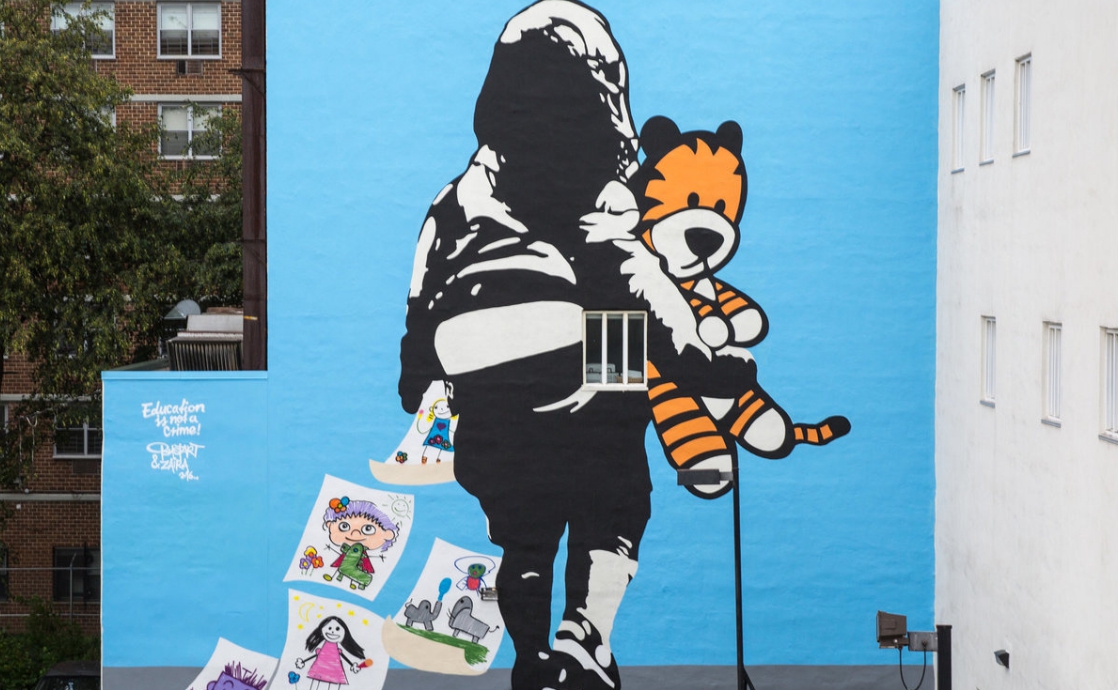The views expressed in our content reflect individual perspectives and do not represent the authoritative views of the Baha'i Faith.
Visual art, especially public art, should engender an emotional response – which explains why the “Education is Not a Crime” mural campaign has touched so many hearts around the world.
That global public mural campaign, which began as a protest against the prohibition of higher education for members of the Baha’i Faith in Iran, also addresses the lack of education for girls in many countries, and even the persecution of journalists.
As people pass by, many stop to study the murals and contemplate the symbolism chosen by the artist. Some find themselves caring about the plight of the subjects, coming to a new awareness of the value of education and the conviction that it is a universal human right.
Creative artists use what’s available, whether it’s a wall or a collection of toys, to get their message across. The renowned Chinese artist Ai Weiwei has been described as “one of China’s most prolific and provocative contemporary artists,” and he uses diverse genres in his quest to promote change and speak through his art to promote themes related to human rights.
RELATED: See a Powerful Play and Alter Your Reality
Trace, one of his most famous visual works, uses Legos to create the faces of detainees and exiles from over thirty mostly Asian countries. On the Smithsonian Institution’s Hirschhorn website, we learn the artist’s philosophy behind the use of a children’s building toy for such an important work of art:
Inspired by his five-year-old son, Ai chose LEGOs as a disarmingly playful and ubiquitous material that can easily be constructed, or deconstructed, on a massive scale — in some ways acting as a metaphor for freedom.
It further explains why he opts to use a wide variety of ordinary object in his works:
Ai is known for appropriating materials such as pearls, porcelain, and salvaged wood in his works, and the artist has a tendency to use mass quantities of objects – and large numbers of volunteers — to help create his work, playing with the dichotomies of individual and collective effort, unity and fragmentation.
Even though his artistic activism led to his being jailed for 81 days in 2011, the website tells us:
… the artist has continued to create art that transcends dualities between East and West, focusing on fundamental questions about the interrelations between art, culture, society, and individual experience.
A good source to learn more about some of the most impactful protest artists is: A Brief History of Protest Art (format.com)
RELATED: Nurturing My Soul Through Creative Collaboration
When I ponder the profound work of protest artists in their quest for justice, I think of these words of Baha’u’llah:
Justice is, in this day, bewailing its plight, and Equity groaneth beneath the yoke of oppression. The thick clouds of tyranny have darkened the face of the earth, and enveloped its peoples. Through the movement of Our Pen of glory We have, at the bidding of the omnipotent Ordainer, breathed a new life into every human frame, and instilled into every word a fresh potency. All created things proclaim the evidences of this world-wide regeneration. This is the most great, the most joyful tidings imparted by the Pen of this wronged One to mankind. Wherefore fear ye, O My well-beloved ones? Who is it that can dismay you? A touch of moisture sufficeth to dissolve the hardened clay out of which this perverse generation is molded.
I pray that the power generated through the deep sense of justice underpinning these artworks will indeed be the moisture that will soften the hardened clay of the hearts which perpetrate the injustices plaguing our world and change that clay into the soil from which positive change will grow and flourish.
















Comments
Sign in or create an account
Continue with Googleor